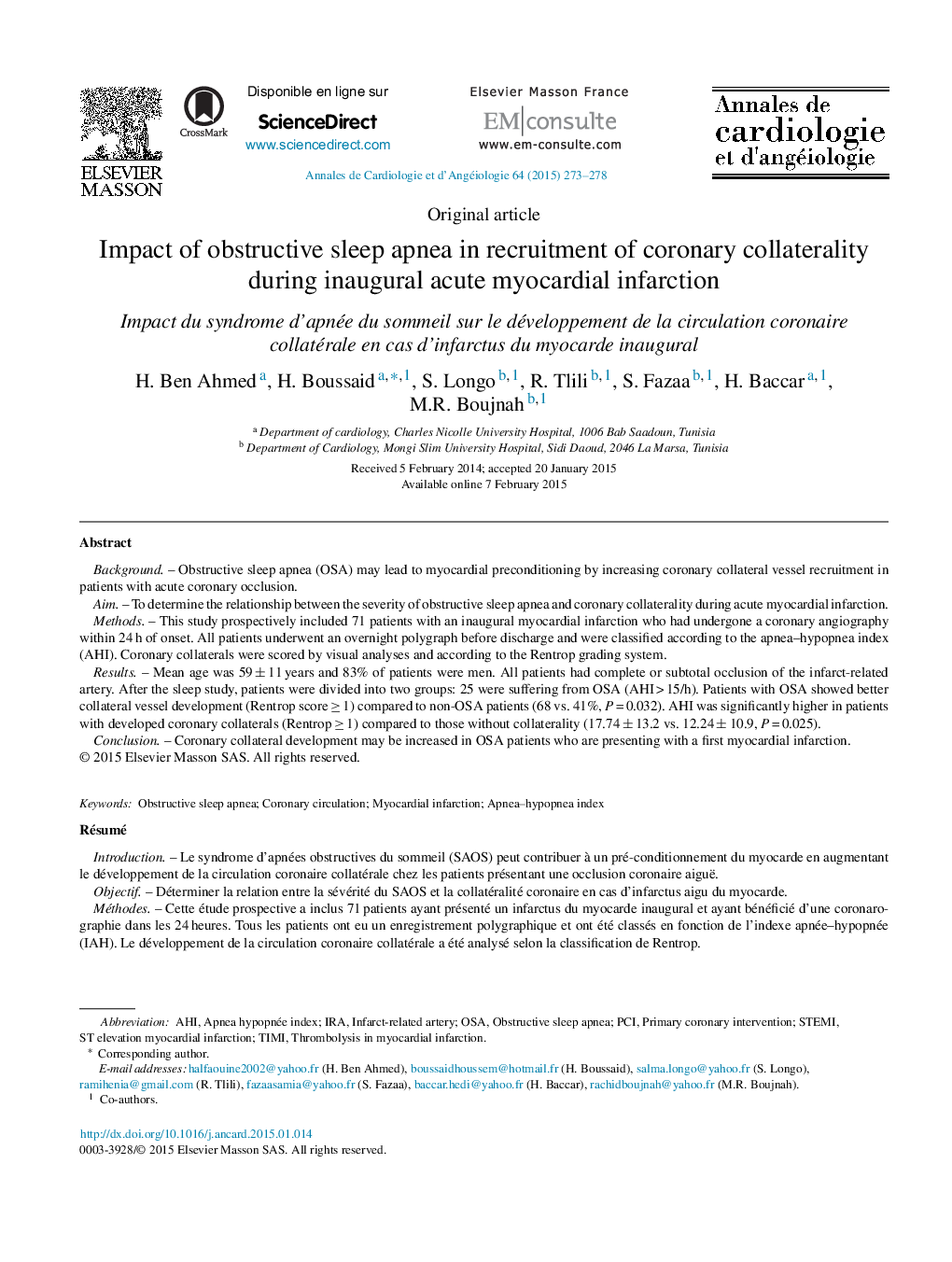| کد مقاله | کد نشریه | سال انتشار | مقاله انگلیسی | نسخه تمام متن |
|---|---|---|---|---|
| 2868523 | 1171199 | 2015 | 6 صفحه PDF | دانلود رایگان |
BackgroundObstructive sleep apnea (OSA) may lead to myocardial preconditioning by increasing coronary collateral vessel recruitment in patients with acute coronary occlusion.AimTo determine the relationship between the severity of obstructive sleep apnea and coronary collaterality during acute myocardial infarction.MethodsThis study prospectively included 71 patients with an inaugural myocardial infarction who had undergone a coronary angiography within 24 h of onset. All patients underwent an overnight polygraph before discharge and were classified according to the apnea–hypopnea index (AHI). Coronary collaterals were scored by visual analyses and according to the Rentrop grading system.ResultsMean age was 59 ± 11 years and 83% of patients were men. All patients had complete or subtotal occlusion of the infarct-related artery. After the sleep study, patients were divided into two groups: 25 were suffering from OSA (AHI > 15/h). Patients with OSA showed better collateral vessel development (Rentrop score ≥ 1) compared to non-OSA patients (68 vs. 41%, P = 0.032). AHI was significantly higher in patients with developed coronary collaterals (Rentrop ≥ 1) compared to those without collaterality (17.74 ± 13.2 vs. 12.24 ± 10.9, P = 0.025).ConclusionCoronary collateral development may be increased in OSA patients who are presenting with a first myocardial infarction.
RésuméIntroductionLe syndrome d’apnées obstructives du sommeil (SAOS) peut contribuer à un pré-conditionnement du myocarde en augmentant le développement de la circulation coronaire collatérale chez les patients présentant une occlusion coronaire aiguë.ObjectifDéterminer la relation entre la sévérité du SAOS et la collatéralité coronaire en cas d’infarctus aigu du myocarde.MéthodesCette étude prospective a inclus 71 patients ayant présenté un infarctus du myocarde inaugural et ayant bénéficié d’une coronarographie dans les 24 heures. Tous les patients ont eu un enregistrement polygraphique et ont été classés en fonction de l’indexe apnée–hypopnée (IAH). Le développement de la circulation coronaire collatérale a été analysé selon la classification de Rentrop.RésultatsL’âge moyen de la population était de 59 ± 11 ans avec 83 % de sexe masculin. Tous les patients avaient une occlusion complète ou subtotale de l’artère coronaire responsable de l’infarctus. Un SAOS (IAH > 15/h) a été identifié chez 25 patients. Une collatéralité coronaire (Rentrop ≥ 1) était plus fréquente chez les patients apnéiques par rapport aux autres patients (68 vs 41 %, p = 0,032). L’IAH était significativement plus élevée chez les patients ayant une circulation coronaire collatérale (Rentrop ≥ 1) par rapport à ceux qui n’ont pas de collatéralité (17,74 ± 13,2 vs 10,9 ± 12,24, p = 0,025).ConclusionLe développement de la circulation coronaire collatérale peut être augmenté chez les patients atteints de syndrome d’apnées obstructives du sommeil se présentant avec un infarctus du myocarde inaugural.
Journal: Annales de Cardiologie et d'Angéiologie - Volume 64, Issue 4, September 2015, Pages 273–278
